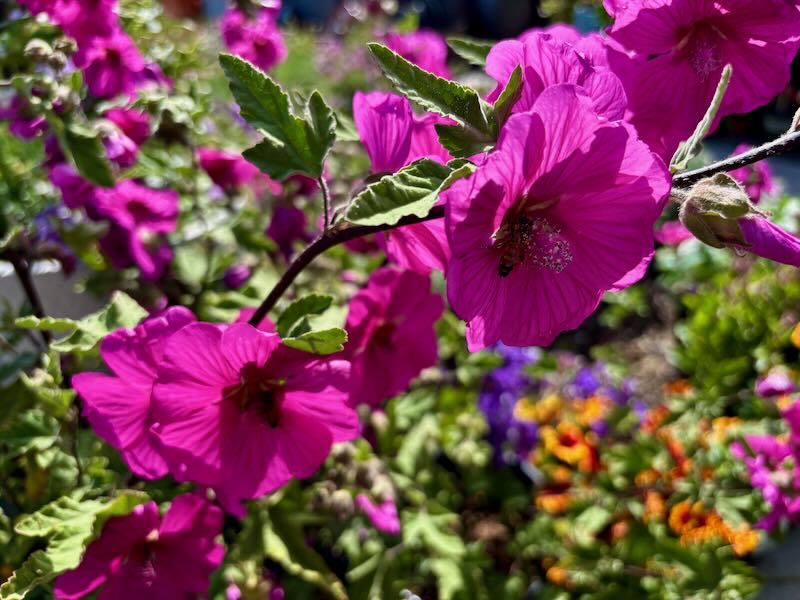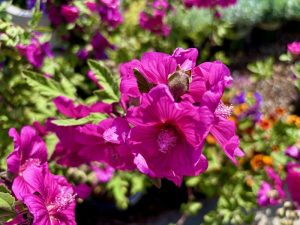Lavatera ‘Red Rum’: compact Tree Mallow with big magenta-red bloom power
Lavatera ‘Red Rum’, also listed as Lavatera × clementii ‘Red Rum’ and sometimes sold under the code ‘Rigrum’, brings a flood of deep pink to magenta-red flowers to small gardens and containers. This compact Tree Mallow (also called Rose Mallow or Shrub Mallow) sits in the Mallow family, Malvaceae, alongside hibiscus and Hollyhocks. It stays bushy, carries soft gray-green leaves, and throws up flower after flower from late spring into fall. Plant it where you want effortless color, quick growth, and nectar for bees.
Meet Lavatera ‘Red Rum’
Gardeners love this cultivar because it works hard without fuss. It forms a rounded, multi-stemmed shrub with a dense, branching habit. Expect 100–150 cm tall (39–59 in) and 90–120 cm wide (35–47 in) at maturity, though size varies with climate and pruning. The foliage is gray-green to blue-green and lightly felted, which helps the plant shrug off heat and sun. Leaves are palmately lobed, usually with three shallow lobes that echo a small maple. On warm days, the plant hums with pollinators. Butterflies and bees visit from breakfast to sunset.
The flowers steal the show. Five silky petals open in a rich magenta-red with a darker eye. Burgundy stems and calyces add contrast and make the petals glow. Each bloom lasts a few days, but the shrub produces them in generous succession, so you see color for months. Stems are perfect for casual cutting; the flowers float well in a small vase on a kitchen counter.
Background and naming of Lavatera ‘Red Rum’
Breeder Ken Rigney selected this interspecific hybrid from Lavatera parents to capture bold color on a compact framework. The name honors Red Rum, the legendary British racehorse, and hints at the plant’s pace and stamina in bloom. In catalogues you may find it as Lavatera × clementii ‘Red Rum’, which reflects hybrid ancestry within the genus. Some modern taxonomies move parts of Lavatera into Malva. In gardens, you will still see it widely as Lavatera, and that is how nurseries label it.
Lavatera ‘Red Rum’ flowers and foliage
Flower size ranges from 6–8 cm across (2.5–3.25 in), and petals sit slightly cupped, like small hibiscus blooms. Color shifts with weather. Cool mornings deepen the red. Intense sun pulls warm pink tones. The darker eye adds depth in both cases. Flowers carry a subtle, clean scent outdoors, most noticeable at midday. The velvety leaves and tidy stems keep the plant attractive between waves of bloom.
Flowering season
You plant this shrub for a long season. Buds often appear in late spring, and the show continues through summer and well into fall. In mild regions, a light flush can linger to first frost. Deadheading extends the run, but even without constant attention the plant keeps pushing new stems and buds. Because it flowers on new growth, you can prune in spring without sacrificing bloom.
Growth habit, size, and landscape uses for Lavatera ‘Red Rum’
The natural form is upright at the base and lightly arching at the tips. That shape works in many settings:
- As a bold, low hedge along a path or driveway
- As the mid-border “color engine” between taller shrubs and edging perennials
- In a large pot on a sunny patio where you want a long, easy display
- In pollinator strips or cottage gardens that rely on steady nectar
Pair it with blue companions—catmint, hardy salvia, Russian sage—to cool the hot magenta. Or lean into a sunset palette with apricot Kniphofia, coral Diascia, and copper sedges. Silver foliage plants like artemisia and wormwood sharpen the bloom color and add drought sense to the planting.
Environmental tolerances
Lavatera ‘Red Rum’ thrives in sun and dry air. Once established, it tolerates short dry spells, especially in lighter soils. It appreciates coastal air and copes with mild salt spray, though it prefers inland drainage to beach-sand saturation. It handles urban conditions and reflects heat from walls or paving. Wind can ruffle the large blooms, so give it a bit of shelter in very exposed sites. Cold remains the main limit. In USDA Zones 7–9 it behaves as a semi-evergreen to evergreen shrub. In Zone 6 it may die back to a woody base in harsh winters and resprout in spring. With a mulch and good drainage, many Zone 6 gardeners keep it going for years.
How to Grow Lavatera ‘Red Rum’
Light
Give it full sun. Aim for 6–8 hours of direct light daily to maximize flower production. In very hot interiors, a touch of late-afternoon shade keeps petals fresh and reduces water stress. Avoid deep shade; stems stretch, flowers drop, and the shrub loses its compact outline.
Soil
Plant it in well-drained ground. A light to medium loam suits it best, but it adapts to sandy or clay soils once you improve structure. Work 5–8 cm (2–3 in) of compost into the top 20–30 cm (8–12 in) at planting. Target pH from 6.0 to 7.5; it tolerates slightly alkaline soil. Avoid spots that hold winter water. If your site stays wet, create a raised berm 10–15 cm high (4–6 in) so the crown sits above pooling.
Watering
Water to establish, then ease off. In the first season, give a deep soak whenever the top 5 cm (2 in) of soil dries. Aim for a thorough wetting to 20–25 cm (8–10 in) depth each time. Mature plants prefer infrequent, deep irrigation over frequent sips. In heat waves, a weekly soak keeps buds coming. In cool spells, stretch the interval. Always water the soil, not the leaves, to discourage rust and stem rot. In containers, check daily in midsummer; pots heat up and dry faster than ground beds.
Fertilizing
Feed lightly. This shrub blooms best on moderate fertility. At planting, mix a modest handful of balanced, slow-release fertilizer into the backfill or top-dress with 2–3 cm (¾–1¼ in) of compost. In spring, repeat the light top-dress. Avoid heavy nitrogen. Too much pushes soft growth that flops and flowers less.
Planting and spacing
Set the top of the root ball level with the surrounding soil. Backfill with amended native soil and firm gently to remove air pockets. Water well to settle the crown. Space plants 90–120 cm apart (35–47 in) to allow air and easy pruning access. For a short hedge, plant 60–75 cm apart (24–30 in) and tip-prune in early summer to knit a uniform line.
Temperature and hardiness
Expect dependable performance in USDA Zones 7–9 and good results in protected Zone 6 sites. In Zone 6 and colder microclimates, treat it as a shrubby perennial that may die back. Mulch 5–7 cm (2–3 in) in late fall to buffer freeze–thaw cycles. In very cold snaps below about −18 °C (0 °F), stems can suffer. Do not rush to cut them; old wood insulates the crown.
Pruning
Prune for structure and bloom. In early to mid-spring, cut back the previous year’s flowering stems to a sturdy framework 20–30 cm high (8–12 in). Remove dead, weak, or crossing wood. Through the season, deadhead by removing spent clusters just above a leaf junction. If the plant surges and gets leggy in midsummer, shear it lightly by a third; it rebounds with a fresh flush of flowers in a few weeks. Avoid hard cuts in late fall, which can invite winter damage.
Mulching
Lay a 5 cm (2 in) organic mulch ring around the drip line to conserve moisture and suppress weeds. Keep mulch a few centimeters off the stems to prevent rot. In colder zones, increase mulch to 7–8 cm (3 in) in late autumn for winter protection, then thin it again in spring as soils warm.
Containers
Lavatera ‘Red Rum’ shines in large pots. Choose a container at least 35–40 cm wide (14–16 in) with generous drainage holes. Use a high-quality, peat-free potting mix with added perlite or fine bark for air. Water when the top 2–3 cm (¾–1¼ in) of mix feels dry. Feed every 4–6 weeks from late spring to midsummer with a balanced liquid fertilizer at half strength. Shelter pots from constant wind so tall stems do not rock and loosen roots.
Propagation of Lavatera ‘Red Rum’
This cultivar roots readily from cuttings, which is how nurseries maintain traits like color and size. Take softwood or semi-ripe cuttings in late spring to midsummer. Cut 8–10 cm (3–4 in) tips from non-flowering shoots. Strip the lower leaves, dip the base in a general-purpose rooting hormone, and insert into a tray filled with a 1:1 mix of perlite and fine compost or a similar airy medium. Maintain high humidity and bright, indirect light at 18–22 °C (64–72 °F). Roots often appear in 3–5 weeks. Pot on into 9–12 cm (3.5–5 in) pots and grow on in a bright, frost-free place for planting out the following spring.
You can also try hardwood cuttings in late autumn. Select pencil-thick young wood, cut 15–20 cm pieces (6–8 in), and insert two-thirds of the length into a sheltered bed of sandy soil. Keep the bed evenly moist over winter. Not every cutting takes; set several to ensure success.
Note: plant introductions sometimes carry breeder’s rights or patents. Respect local regulations before propagating named cultivars for sale.
Pests and diseases
This shrub stays relatively clean, but all mallows share a few risks. Aphids can cluster on new tips in spring. A sharp jet of water dislodges most. Lady beetles and hoverflies often finish the job if you avoid broad-spectrum insecticides. Spider mites may appear in hot, dusty stretches; rinse foliage in the morning once or twice a week and use horticultural oil if populations build.
Rust can spot leaves in wet, humid cycles. The orange to brown pustules sit on the undersides of leaves. Improve spacing, avoid overhead watering, and remove heavily spotted leaves. Where rust recurs, a labeled organic fungicide applied preventively as new foliage forms can help. Botrytis and stem rot strike when drainage fails or when mulch rides up the stems. Keep the crown dry, water the soil, and prune for airflow.
Deer usually ignore Lavatera foliage, and rabbits seldom bother established shrubs. In coastal belts, salt spray rarely troubles it, but constant wind can fray petals; a light fence or hedge upwind solves that.
Seasonal calendar for Lavatera ‘Red Rum’
- Late winter to early spring: Assess winter dieback. Prune to a low, sturdy framework 20–30 cm (8–12 in) tall. Top-dress with compost.
- Mid-spring: Plant new shrubs once frost danger passes. Start softwood cuttings as shoots extend.
- Early to midsummer: Deadhead regularly. Lightly tip-prune if stems stretch. Maintain deep, infrequent watering.
- Late summer to early fall: Enjoy peak bloom. Take semi-ripe cuttings for next year’s stock if desired.
- Late fall: Reduce irrigation as temperatures drop. Mulch crowns in cold zones. Leave skeletal stems in Zone 6 gardens to shield the base.
Troubleshooting common issues
If the plant flops after heavy rain, your soil likely holds too much water. Raise the planting area and prune harder in spring to stiffen the framework. If flowers thin in midsummer, check light levels. Trees may have leafed out and shaded the bed; move the shrub next spring or thin nearby branches. If leaves yellow from the bottom up but veins stay green, suspect hungry soil. Add a light top-dress of compost and a small dose of balanced fertilizer, then water deeply. If winter kills stems to the ground in a Zone 6 site, do not panic. Wait for new shoots from the base and rebuild the shrub over the season.
Design notes and companions
Use repetition for impact. Three shrubs spaced about 90 cm apart (35 in) create a broad splash of color. Soften the front edge with Blue Catmint (Nepeta) or Silver Germander (Teucrium fruticans), both drought-wise partners. For a bee buffet, weave in Salvia nemorosa, Eryngium, and Oregano. In containers, pair Lavatera ‘Red Rum’ with trailing Helichrysum ‘Icicles’ and a vertical accent like purple fountain grass for height and movement.
Cut-flower tips
Cut stems in the cool morning when the first bloom on a cluster is fully open and several buds are showing color. Strip leaves that would sit below the waterline. Recut stems under water and place them in a clean vase with preservative. Expect 4–6 days indoors in a bright, cool room. Because the petals are satiny, avoid fans or direct blasts of air that can bruise them.
Why choose Lavatera ‘Red Rum’
You get a compact shrub with a long bloom season, bold color, and strong garden manners. It asks for sun, drainage, and a simple spring haircut. In return, it flowers for months, feeds pollinators, and slots into borders or pots without drama. If you garden in Zones 7–9, it behaves as an easy, semi-evergreen shrub. In Zone 6, it performs as a resilient, shrubby perennial that rewards a bit of winter protection. Either way, Lavatera ‘Red Rum’ makes a small space look generous and a large border feel lively from spring to frost.



